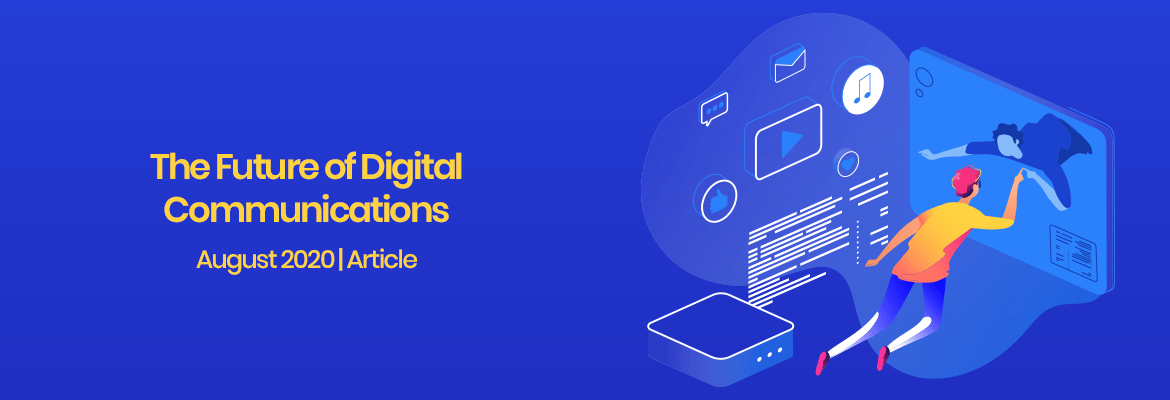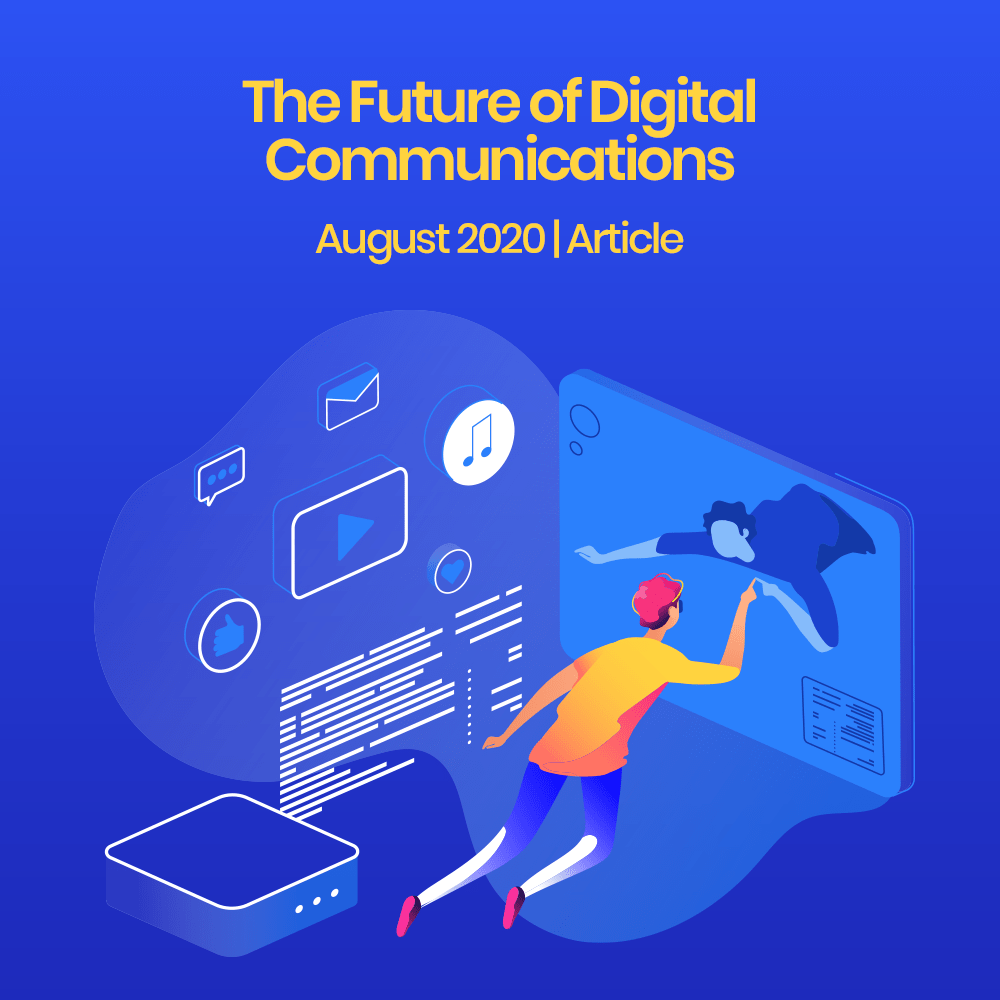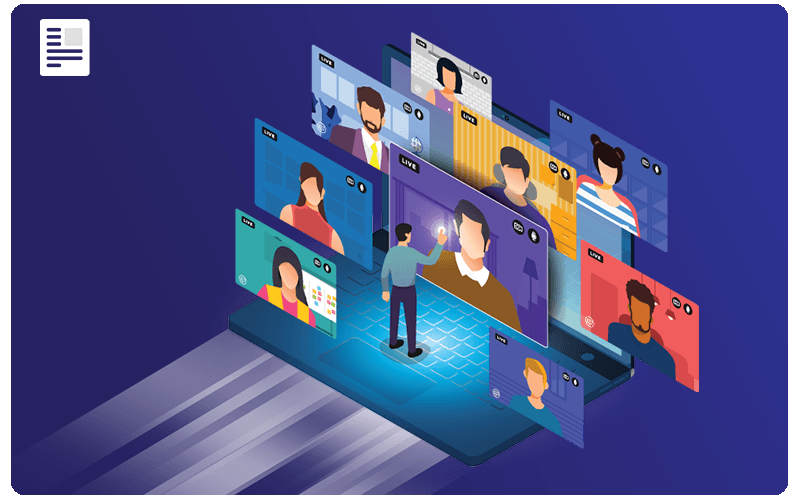

The dramatic shift to online everything (at least till the manageable end of Covid-19), has impacted the expectation dynamics of relationships with customers and employees. As a result, organizations are quickly (some haphazardly) learning to engage them better, manage practices efficiently, eliminate silos and up their focus on communication early and often. However, most are not ready to combat the challenges of this pandemic and beyond, not only on the business aspects of digitization and automation, but also on the digitally enabled aspects of internal and external communications. This makes one wonder about the growing importance of comprehending the evolving and multidimensional dynamic of digital communications and the significant role it is starting to play in the business of business of the future. And while multiple factors are at play in terms of where this discipline is headed, there are certain clear ones that are impacting the shape it will take.
5G; the white knight
The fifth-generation cellular network, 5G, will completely change the shape of daily human life, redefining how individuals and organizations connect, inform, shop and entertain. Wireless networks will reach unprecedented speeds with its high bandwidth and low latency, equipping new technologies with futuristic capabilities. Moreover, it will pave the way for new tools, models and opportunities for organizations with an improved data capacity and the ability to efficiently leverage it. The 5G revolution is just about to take off. It will completely redefine the way internal communications take place by enhancing operational efficiency and making the decision-making process smoother and employee engagement better. On the external side of communications, a more fruitful gift awaits. 5G holds the potential to rebalance the power between consumers, investors and business leadership. Meetings will play out more transparently, more consumer data will be generated to be analyzed and evaluated, dashboards will display a history of revenues and expenditures; essentially, all vital metrics will be updated in real-time and powered by artificial intelligence. At its best, 5G will enable a thriving information flow and change the way organizations communicate forever.
The AI Paradigm
According to Gartner, 37% of organizations have already implemented AI in some form, a 270% increase from 2016 to 2020. By 2021, 80% of emerging technologies are also said to be AI powered with chatbots, artificial personal assistants, virtual and augmented reality etc. The impact of Chatbots alone is significant in not only automating contact center services, but its ability to proactively engage with customers to respond to their queries or provide product or other guidance is significant and on a continuous rise. AI also has the potential to make outreach strategies more efficient by providing a hyper-personalized experience since AI is both understanding and learning from human responses to communication. In fact, it is already using customer data such as recent purchases made by user, to cater personalized messaged that will interest them. This can process can allow organizations to split their audience into certain demographics and communicate with each individual customer uniquely. Some experts believe that banks will be able to automate up to 90% of their customer interactions through chatbots by 2022. Another AI empowered trend that can benefit banks is blockchain. With blockchain, single ledger entries that two parties have access to can simplify the coordination and validation efforts for banks with one single version of records, not two disparate databases. Similarly, artificial personal assistants like Alexa and Google ‘Duplex’ are continuing to become increasingly intelligent and can be used for making phone calls whilst adopting characteristics of human speech, scheduling meetings, organizing calendars and even transcribing discussions.
Virtual is the new reality
There are many use cases linked to VR that demonstrate its ability to enhance conference calls and delivery of professional trainings. Imagine a business meeting being held with people from around the world and demonstrating your ideas by sharing 360 visuals. This allows for creative feedback and making changes with approval cues from everyone present at the virtual meeting on the spot. Future pandemics or other disruptions can be better combatted through such services too and with the onset of Covid-19 and remote work being encouraged, this method cannot only prove to be convenient, but effective too. Technology allowing people to immerse themselves and react to a virtual environment is a fascinating concept, and when perfected, will play a big role in business communication. Heathrow Airport has introduced VR into their services. This is a great example of how early forms of VR are being used within businesses. The service allows passengers to look around the airport from their smartphones, with the idea that they can avoid wandering aimlessly when trying to find their terminal or a store in duty-free.
Productivity Tools & the Social Intranet
Social intranet software includes features such as instant messaging, social tagging, document and story sharing, a newsfeed, personal profiles and many more. Organizations are harnessing the power of G-Suite to improve their collaboration, communication and productivity. The G-Suite intranet can provide seamless connection and collaboration in an interface the younger generations workforce has grown up with and raised by, i.e.- Google’s. G suite allows an organization’s documents, calendars, and directories to be seamlessly integrated to an intranet software which gives them access to information and people instantly. Cross-functional teamwork is something Google apps make smoothly possible. Examining the need for communication during the Covid-19 crisis, Google offered an all-in-one enterprise social intranet that combines intranet functionality with collaboration features and social networking to keep the global workforce connected regardless of where they were located. Integration of the new generation of intranet with tools like Slack and Teams is proving to be an ideal hub for team work and are looking to add voice and video for better and faster communication too. In the years ahead, social intranet will continue to advance and help organizations reach new communications milestones.
Real-time communication with WebRTC
WebRTC is a web-oriented and open source Voice over IP technology that instills real time communication capabilities in a browser. It is a new(er) framework that can be leveraged by forward thinking organizations to enhance their business communications without needing software integrators or training sessions. By leveraging this technology, organizations can have video conferences and collaborate with others using an internet browser. Google has already embraced this technology and has approximately 2 billion Chrome browsers with WebRTC and 1 billion WebRTC audio/video minutes per week on Chrome too. WebRTC supports remote communications from audio, chat and video, to content sharing and screen sharing. Furthermore, AI-enabled contact centers also use WebRTC to make and receive calls within a contact center application, making it possible to retain customer conversations in one place. Since the number of remote workers have shot up dramatically in 2020 and expected to grow from here onwards, organizations have the opportunity to take on freelancers and remote workers too as they will have the perfect communication technology in place with the help of WebRTC.
Cloud – the nucleus of all communications
60% of financial services companies have already reported they’ll be implementing cloud technology to enhance their communications. The connective tissue of cloud communications, however, is CPaaS. CPaaS (Communications Platform as a Service) will dominate the roadmap for business communications and collaborations with its flexible and customizable solutions, according to research analysts. CPaaS refers to a cloud-based platform that integrates communication services such as SMS, email, voice, RCS, chatbots or any microservice into existing back-end systems and applications. Using APIs and intelligent interconnectivity to enable each service, CPaaS providers connect to every channel and service. In this ever-evolving environment, organizations are using cutting-edge technologies to keep up with their competitors and with CPaaS adoption they can serve multiple and fluctuating communication needs. An organization taking advantage of the wide arrays of CPaaS benefits is the Metropolitan Utilities District in Nebraska that provides water and gas to one-third of the state. They have a 360-degree view of their customers and can reach out to them via phone call or live chat whenever a problem arises. Metropolitan can view the details of their contracts and invoices, making them resolve customer complaints at first contact. While this use-case involves a state district with a large budget, deploying a new innovation like CPaaS can be done at a minimal cost by organizations of all sizes, in fact, Global Newswire and Juniper Research have found that it has been leveraged (and also provided) by countless start-ups. Another impressive feature of CPaaS is that it allows multi-tenancy, i.e., the ability for multiple customers to use the service at the same time, each within a separate secure environment. This can enable an organization to cater to multiple communication needs at the same time.
Be the future; The TransformX way
Each organization has its own set of unique needs and goals in terms of communication. Each trend that dictates the way companies communicate with their employees, customers, and other businesses, depends on their individual purpose. A well-crafted business communications strategy has the power to remarkably support all avenues and aspects being reviewed and realigned for the new normal. Effective communications re-establish and strengthen the relationship between an organization and its stakeholders; build trust and motivate employees returning to a different workplace; and lastly, massively improve the rapport an organization is seeking to create between themselves and their customers. The TransformX approach enables organizations in rethinking customer experience through innovative and disruptive methods of communication. Our signature Cloud Communications offering helps clients carefully select new CPaaS solutions (or replace existing ones) as a result of a deep study of organizational, functional, and technical dynamics. A comprehensive review of the merits and demerits of the existing CPaaS solution(s) is also offered along with CPaaS program oversight initiatives. We look forward to assisting you in your digital and customer transformation journey by combining elements of the above mentioned Cloud Communications sub offerings — New CpaaS Acquisition, Existing CPaaS Review, and CPaaS Program Oversight. Time doesn’t wait, start your journey with us now.
The dramatic shift to online everything (at least till the manageable end of Covid-19), has impacted the expectation dynamics of relationships with customers and employees. As a result, organizations are quickly (some haphazardly) learning to engage them better, manage practices efficiently, eliminate silos, and up their focus on communication early and often. However, most are not ready to combat the challenges of this pandemic and beyond, not only on the business aspects of digitization and automation but also on the digitally enabled aspects of internal and external communications. This makes one wonder about the growing importance of comprehending the evolving and multidimensional dynamic of digital communications and the significant role it is starting to play in the business of the future. And while multiple factors are at play in terms of where this discipline is headed, there are certain clear ones that are impacting the shape it will take.
5G; the white knight
The fifth-generation cellular network, 5G, will completely change the shape of daily human life, redefining how individuals and organizations connect, inform, shop, and entertain. Wireless networks will reach unprecedented speeds with its high bandwidth and low latency, equipping new technologies with futuristic capabilities. Moreover, it will pave the way for new tools, models, and opportunities for organizations with improved data capacity and the ability to efficiently leverage it. The 5G revolution is just about to take off. It will completely redefine the way internal communications take place by enhancing operational efficiency and making the decision-making process smoother and employee engagement better. On the external side of communications, a more fruitful gift awaits. 5G holds the potential to rebalance the power between consumers, investors, and business leaders. Meetings will play out more transparently, more consumer data will be generated to be analyzed and evaluated, dashboards will display a history of revenues and expenditures; essentially, all vital metrics will be updated in real-time and powered by artificial intelligence. At its best, 5G will enable thriving information flow and change the way organizations communicate forever.
The AI Paradigm
According to Gartner, 37% of organizations have already implemented AI in some form, a 270% increase from 2016 to 2020. By 2021, 80% of emerging technologies are also said to be AI-powered with chatbots, artificial personal assistants, virtual and augmented reality, etc. The impact of Chatbots alone is significant in not only automating contact center services, but its ability to proactively engage with customers to respond to their queries or provide products or other guidance is significant and on a continuous rise. AI also has the potential to make outreach strategies more efficient by providing a hyper-personalized experience since AI is both understanding and learning from human responses to communication. In fact, it is already using customer data such as recent purchases made by users, to cater to the personalized messages that will interest them. This can process can allow organizations to split their audience into certain demographics and communicate with each individual customer uniquely. Some experts believe that banks will be able to automate up to 90% of their customer interactions through chatbots by 2022. Another AI-empowered trend that can benefit banks is blockchain. With blockchain, single ledger entries that two parties have access to can simplify the coordination and validation efforts for banks with one single version of records, not two disparate databases. Similarly, artificial personal assistants like Alexa and Google ‘Duplex’ are continuing to become increasingly intelligent and can be used for making phone calls whilst adopting characteristics of human speech, scheduling meetings, organizing calendars, and even transcribing discussions.
Virtual is the new reality
There are many use cases linked to VR that demonstrate its ability to enhance conference calls and delivery of professional training. Imagine a business meeting being held with people from around the world and demonstrating your ideas by sharing 360 visuals. This allows for creative feedback and making changes with approval cues from everyone present at the virtual meeting on the spot. Future pandemics or other disruptions can be better combatted through such services too and with the onset of Covid-19 and remote work being encouraged, this method cannot only prove to be convenient but effective too. Technology allowing people to immerse themselves and react to a virtual environment is a fascinating concept, and when perfected, will play a big role in business communication. Heathrow Airport has introduced VR into their services. This is a great example of how early forms of VR are being used within businesses. The service allows passengers to look around the airport from their smartphones, with the idea that they can avoid wandering aimlessly when trying to find their terminal or a store in duty-free.
Productivity Tools & the Social Intranet
Social intranet software includes features such as instant messaging, social tagging, document and story sharing, a newsfeed, personal profiles, and many more. Organizations are harnessing the power of G-Suite to improve their collaboration, communication, and productivity. The G-Suite intranet can provide seamless connection and collaboration in an interface the younger generations workforce has grown up with and raised by, i.e.- Google’s. G suite allows an organization’s documents, calendars, and directories to be seamlessly integrated to an intranet software which gives them access to information and people instantly. Cross-functional teamwork is something Google apps make smoothly possible. Examining the need for communication during the Covid-19 crisis, Google offered an all-in-one enterprise social intranet that combines intranet functionality with collaboration features and social networking to keep the global workforce connected regardless of where they were located. The integration of the new generation of intranet with tools like Slack and Teams is proving to be an ideal hub for teamwork and is looking to add voice and video for better and faster communication too. In the years ahead, the social intranet will continue to advance and help organizations reach new communications milestones.
Real-time communication with WebRTC
WebRTC is a web-oriented and open source Voice over IP technology that instills real-time communication capabilities in a browser. It is a new(er) framework that can be leveraged by forward-thinking organizations to enhance their business communications without needing software integrators or training sessions. By leveraging this technology, organizations can have video conferences and collaborate with others using an internet browser. Google has already embraced this technology and has approximately 2 billion Chrome browsers with WebRTC and 1 billion WebRTC audio/video minutes per week on Chrome too. WebRTC supports remote communications from audio, chat, and video, to content sharing and screen sharing. Furthermore, AI-enabled contact centers also use WebRTC to make and receive calls within a contact center application, making it possible to retain customer conversations in one place. Since the number of remote workers has shot up dramatically in 2020 and expected to grow from here onwards, organizations have the opportunity to take on freelancers and remote workers too as they will have the perfect communication technology in place with the help of WebRTC.
Cloud – the nucleus of all communications
60% of financial services companies have already reported they’ll be implementing cloud technology to enhance their communications. The connective tissue of cloud communications, however, is CPaaS. CPaaS (Communications Platform as a Service) will dominate the roadmap for business communications and collaborations with its flexible and customizable solutions, according to research analysts. CPaaS refers to a cloud-based platform that integrates communication services such as SMS, email, voice, RCS, chatbots, or any microservice into existing back-end systems and applications. Using APIs and intelligent interconnectivity to enable each service, CPaaS providers connect to every channel and service. In this ever-evolving environment, organizations are using cutting-edge technologies to keep up with their competitors and with CPaaS adoption they can serve multiple and fluctuating communication needs. An organization taking advantage of the wide array of CPaaS benefits is the Metropolitan Utilities District in Nebraska that provides water and gas to one-third of the state. They have a 360-degree view of their customers and can reach out to them via phone call or live chat whenever a problem arises. Metropolitan can view the details of their contracts and invoices, making them resolve customer complaints at first contact. While this use-case involves a state district with a large budget, deploying a new innovation like CPaaS can be done at a minimal cost by organizations of all sizes, in fact, Global Newswire and Juniper Research have found that it has been leveraged (and also provided) by countless start-ups. Another impressive feature of CPaaS is that it allows multi-tenancy, i.e., the ability for multiple customers to use the service at the same time, each within a separate secure environment. This can enable an organization to cater to multiple communication needs at the same time.
Be the future; The TransformX way
Each organization has its own set of unique needs and goals in terms of communication. Each trend that dictates the way companies communicate with their employees, customers, and other businesses, depends on their individual purpose. A well-crafted business communications strategy has the power to remarkably support all avenues and aspects being reviewed and realigned for the new normal. Effective communications re-establish and strengthen the relationship between an organization and its stakeholders; build trust and motivate employees returning to a different workplace; and lastly, massively improve the rapport an organization is seeking to create between themselves and their customers. The TransformX approach enables organizations in rethinking customer experience through innovative and disruptive methods of communication. Our signature Cloud Communications offering helps clients carefully select new CPaaS solutions (or replace existing ones) as a result of a deep study of organizational, functional, and technical dynamics. A comprehensive review of the merits and demerits of the existing CPaaS solution(s) is also offered along with CPaaS program oversight initiatives. We look forward to assisting you in your digital and customer transformation journey by combining elements of the above mentioned Cloud Communications sub offerings — New CpaaS Acquisition, Existing CPaaS Review, and CPaaS Program Oversight. Time doesn’t wait, start your journey with us now.




